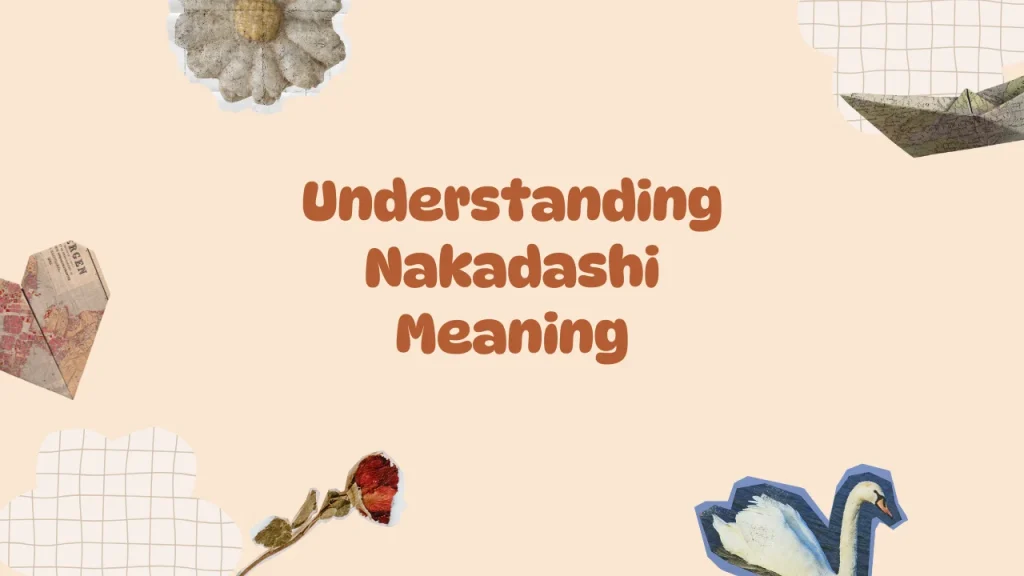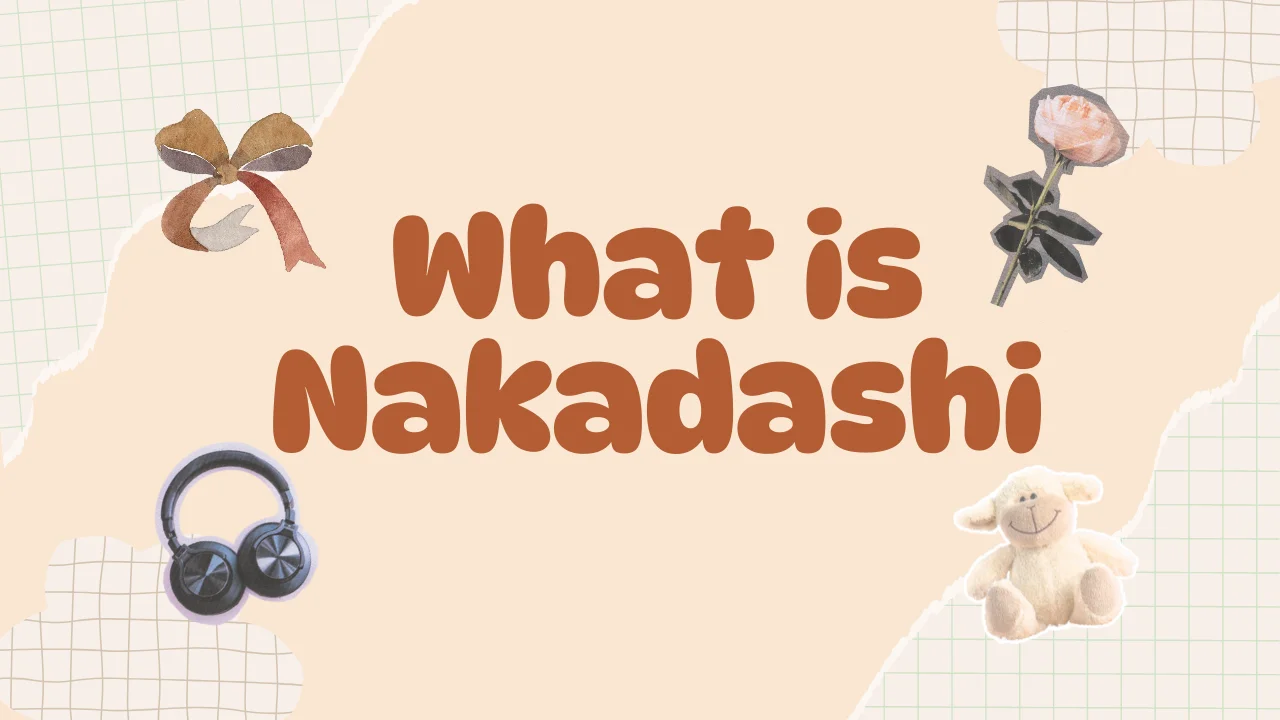What is Nakadashi? Japanese Slang Explained
You’re scrolling through anime forums or chatting with friends about Japanese pop culture, and suddenly, the term nakadashi pops up. Maybe you’re curious, maybe you’re confused, or maybe you’re just trying to figure out what it means without falling down a rabbit hole of awkward Google searches. Don’t worry—I’ve got you covered. In this guide, I’ll break down what is nakadashi, its meaning, context, and cultural significance in a way that’s clear, approachable, and respectful. By the end, you’ll not only understand nakadashi but also get a peek into Japanese slang, related terms like kyokai and kosei, and even slang like JK. Let’s dive in!
Understanding Nakadashi Meaning

The term nakadashi is a Japanese word that’s often misunderstood or taken out of context, especially in Western circles. To get it right, we need to explore its literal meaning, cultural roots, and how it’s used today.
Literal Nakadashi Definition
Nakadashi comes from two Japanese words: naka (inside) and dashi (to release or let out). Literally, it translates to “releasing inside.” In its most common usage, nakadashi is a term associated with adult entertainment in Japan, referring to a specific act in adult films. It’s a straightforward term in this context, but its implications and usage are nuanced.
Nakadashi in Adult Entertainment
In Japanese adult entertainment, nakadashi is a genre or descriptor used in adult videos (AV). It’s explicit and tied to a specific act, which is why the term often raises eyebrows outside Japan. However, it’s not a casual slang term thrown around in everyday conversation—it’s niche and mostly confined to this industry. If you’re researching nakadashi meaning, this is the primary context you’ll encounter.
Cultural Context of Nakadashi
Japanese culture is layered, with strict boundaries between public and private spheres. Nakadashi, as a term, stays firmly in the private, adult-oriented world. It’s not something you’d hear in polite company or see in mainstream media like anime or manga, despite what some online forums might suggest. Understanding this helps you grasp why the term feels “taboo” or sensitive.
Misconceptions About Nakadashi
Many people assume nakadashi is a common Japanese slang term or something you’d find in anime. That’s a myth. It’s specific to adult content and rarely appears outside that context. If you’re exploring Japanese pop culture, you’re more likely to encounter terms like JK or kosei in casual settings. In my experience, confusing nakadashi with mainstream slang can lead to awkward misunderstandings—trust me, I’ve seen it happen!
| Term | Context | Common Usage |
| Nakadashi | Adult entertainment | Refers to a specific act in AV |
| JK | Japanese slang | High school girl, used in casual or otaku contexts |
| Kosei | General Japanese | Individuality or personality |
Japanese Slang and Nakadashi
To fully understand what is nakadashi, it helps to zoom out and look at Japanese slang as a whole. Japan’s language is rich with colloquialisms, and terms like nakadashi, JK, kyokai, and kosei each have their own place in the linguistic landscape.
What is Japanese Slang For?
Japanese slang is a vibrant part of the language, often tied to youth culture, subcultures, or specific communities like otaku (anime fans). Slang terms evolve quickly, reflecting trends in Japanese pop culture. For example, nakadashi is slang within the adult industry, while terms like JK are more common in everyday or anime-related conversations. Slang adds flavor to the language but can be tricky for outsiders to navigate.
What is a JK in Japanese Slang?
JK stands for joshi kosei, meaning “high school girl.” It’s a popular term in Japanese slang, especially in anime and manga communities. JK can refer to actual high school girls or be used playfully to describe youthful, energetic characters. Unlike nakadashi, JK is lighthearted and widely used in casual settings. If you’re exploring anime slang terms, JK is one you’ll see often.
What is Kosei in English?
Kosei translates to “individuality” or “personality” in English. It’s a positive term used to describe someone’s unique traits or character. For instance, a teacher might praise a student’s kosei for their creativity. It’s unrelated to nakadashi but shows how diverse Japanese language can be, with terms ranging from everyday to niche.
What is Kyokai in Japanese?
Kyokai means “boundary” or “association” in Japanese, depending on the context. For example, it can refer to a professional group (like a medical association) or a literal boundary. It’s a formal term, unlike nakadashi or JK, and you might encounter it in academic or professional settings. Knowing terms like kyokai helps you appreciate the breadth of Japanese colloquialisms.
Here’s a tip I always give beginners: When learning Japanese slang, context is everything. A term like nakadashi might seem intriguing, but using it incorrectly can lead to embarrassment. Stick to safer slang like JK or kosei in casual chats!
Nakadashi in Japanese Pop Culture
You might wonder if nakadashi has a place in Japanese pop culture, like anime or manga. The short answer? Not really. Let’s explore why and look at related terms that do appear in these spaces.
Nakadashi and Anime Misconnections
Some online discussions link nakadashi to anime terminology, but this is largely a misconception. Anime and manga rarely, if ever, reference nakadashi due to its explicit nature. Instead, you’ll find terms like JK or phrases tied to Japanese subculture in these media. If you’re researching nakadashi in anime, you’re likely hitting a dead end.
Japanese Subculture and Slang
Japanese subculture, including otaku and gaming communities, thrives on unique slang. Terms like JK or kawaii (cute) dominate these spaces, reflecting the playful side of Japanese pop culture. Nakadashi, by contrast, stays in its adult niche. Understanding this divide helps you navigate Japanese media without mixing up contexts.
Role of Urban Dictionary
If you’ve looked up nakadashi on Japanese urban dictionary sites or Western equivalents, you might see colorful definitions. These platforms are great for decoding slang in Japan, but they can exaggerate or misrepresent terms. For nakadashi, stick to reputable sources to avoid confusion.
Cultural Sensitivity
Japanese culture values discretion, especially around adult topics. Nakadashi isn’t a term to toss around lightly, even in casual settings. If you’re curious about Japanese linguistic trends, focus on widely accepted slang like JK or kosei to stay respectful.
| Slang Term | Meaning | Cultural Context |
| JK | High school girl | Anime, youth culture |
| Kosei | Individuality | General, positive use |
| Nakadashi | Releasing inside | Adult entertainment, niche |
How to Approach Nakadashi Discussions
Talking about nakadashi can feel like walking on eggshells, especially if you’re new to Japanese slang terms. Here are some practical tips to handle it respectfully and avoid awkward moments.
Research Before Speaking
Before using nakadashi in conversation, understand its adult context. Check reliable sources or Japanese slang dictionaries to confirm its meaning. Misusing it could offend someone or make you seem out of touch. What I learned the hard way is that not every Japanese term is safe for casual chats—nakadashi included.
Stick to Appropriate Contexts
If you’re discussing Japanese adult terms, keep it professional or academic. For example, you might analyze nakadashi in a study of Japanese media or adult entertainment trends. In casual settings, pivot to terms like JK or kosei to keep things light.
Respect Cultural Norms
Japanese culture prioritizes respect and subtlety. Avoid bringing up nakadashi unless it’s relevant and the setting is appropriate. If you’re unsure, ask a trusted friend or language expert about Japanese colloquialisms first.
Learn Related Slang
To broaden your understanding, explore other anime slang terms or Japanese urban dictionary entries. Terms like kyokai (boundary) or kosei (individuality) are safer and more versatile for everyday use.
Stay Curious, Stay Respectful
Curiosity about Japanese language is awesome, but balance it with respect. If you’re diving into nakadashi cultural impact, approach it as a learning opportunity, not a sensational topic.
| Do | Don’t |
| Research nakadashi context | Use nakadashi casually |
| Stick to adult-oriented discussions | Assume it’s anime slang |
| Learn related terms like JK | Ignore cultural norms |
Actionable Tips for Learning Japanese Slang
Want to master Japanese slang and avoid pitfalls like misusing nakadashi? Here are five actionable tips to guide you:
1. Start with Reputable Sources
Use language apps like Duolingo or websites like Tofugu to learn Japanese slang terms. They’re reliable and beginner-friendly.
2. Watch Anime with Subtitles
Anime is a goldmine for slang like JK or kawaii. Watch with subtitles to catch terms in context.
3. Join Online Communities
Reddit’s r/LearnJapanese or anime forums are great for asking about Japanese colloquialisms. Just avoid sensitive topics like nakadashi.
4. Practice with Native Speakers
Language exchange apps like Tandem connect you with native speakers. Ask about terms like kosei or kyokai to build confidence.
5. Keep a Slang Journal
Write down new terms like JK, kosei, or even nakadashi with their meanings and contexts. Review weekly to reinforce learning.
FAQs About Nakadashi and Japanese Slang
What does nakadashi mean in Japanese?
Nakadashi literally means “releasing inside” and is a term used in Japanese adult entertainment to describe a specific act. It’s not common in everyday conversation.
Is nakadashi used in anime or manga?
No, nakadashi is rarely, if ever, used in anime or manga due to its explicit nature. Terms like JK or kawaii are more common in these contexts.
What is a JK in Japanese slang?
JK stands for joshi kosei, meaning “high school girl.” It’s a playful term used in anime slang terms and youth culture.
What is kosei in English?
Kosei translates to “individuality” or “personality.” It’s a positive term used to describe someone’s unique traits.
What is kyokai in Japanese?
Kyokai means “boundary” or “association,” often used in formal or professional contexts, unlike nakadashi or JK.
Why is nakadashi controversial?
Nakadashi is tied to adult content, making it sensitive in Japanese culture, where discretion is valued. It’s not a term for casual use.
Read More: Costway Chair Model 5T0329347 Parts Manual: All You Need To Know
Wrapping Up
So, what is nakadashi? It’s a Japanese term meaning “releasing inside,” primarily used in adult entertainment Japan. Unlike Japanese slang like JK (high school girl) or kosei (individuality), nakadashi is niche and explicit, not part of mainstream Japanese pop culture. By understanding its context, you can navigate Japanese language with confidence and respect. Whether you’re curious about kyokai (boundary) or other anime slang terms, keep learning and stay mindful of cultural norms. Got more questions? Drop them below, and let’s keep the conversation going!
Meta Title: What is Nakadashi? Japanese Slang Explained

Sarah Wilson is a skilled writer who works in many different areas. She creates interesting and helpful content, sharing useful information and keeping readers engaged with her knowledge and love for a wide range of topics.





